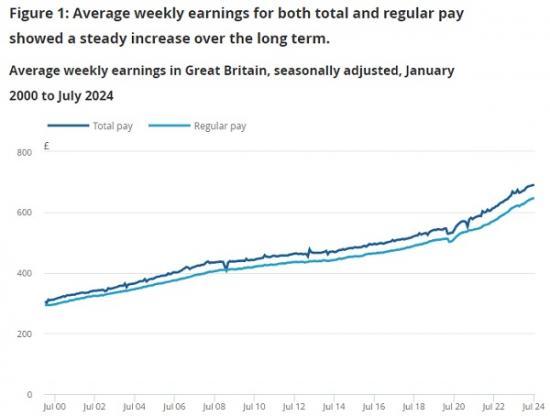Average Weekly Earnings In Great Britain - September 2024
10th September 2024

Annual growth in employees' average regular earnings (excluding bonuses) was 5.1%; growth was last lower than this in April to June 2022, when it was 4.7%.
Annual growth in total earnings (including bonuses) was 4.0%; this total growth rate is affected by the NHS and civil service one-off payments made in June and July 2023.
Annual growth in real terms (adjusted for inflation using the Consumer Prices Index including owner occupiers' housing costs (CPIH)) was 2.2% for regular pay and 1.1% for total pay.
Annual average regular earnings growth for the public sector remains strong at 5.7%, although down on the previous three-month period (6.0%); for the private sector this was 4.9%, with growth last lower than this in February to April 2022 (4.8%).
The manufacturing sector saw the largest annual regular growth rate at 5.9%, while the construction sector saw the smallest annual regular growth rate at 3.9%.
The annual growth for regular earnings (excluding bonuses) was 5.1% in May to July 2024. Growth was last lower than this in April to June 2022, when it was 4.7%.
Annual growth in employees' average total earnings (including bonuses) was 4.0%. However, this total pay annual growth rate is affected by the NHS and civil service one-off non-consolidated payments made in June and July 2023, causing a base effect. See the Sector and industry section for further details. There is also a similar pattern in the HM Revenue and Customs (HMRC) data in the Earnings and employment from Pay As You Earn Real Time Information, UK bulletin.
In real terms (adjusted for inflation using the Consumer Prices Index including owner occupiers' housing costs (CPIH)), real regular pay growth on the year was 2.2% in May to July 2024, down on the previous three-month period, when it was 2.4%. Total real pay rose by 1.1% on the year in May to July 2024; again this is affected by the NHS and civil service one-off non-consolidated payments made in June and July 2023.
Annual average regular earnings growth for the public sector remains strong at 5.7% in May to July 2024, although down on the previous three-month period (6.0%) (Figure 4). For the private sector, this was 4.9%, and growth was last lower in February to April 2022 (4.8%).
Annual average total earnings growth for the public sector was 0.8% in May to July 2024. However, this is affected by the NHS and civil service one-off non-consolidated payments made in June and July 2023. Looking at the single-month annual growth for the public sector in July and June 2024, we saw small growth or decreases on the year.
For July 2024, the annual total earnings growth for the public sector was 2.4%. This was because of the public administration industry, which saw a decrease on the year of 6.1%. For June 2024, the annual total earnings growth for the public sector saw a decrease on the year of 5.7%. This was because of the health and social work industry, which saw a decrease on the year of 11.7%.
For the private sector, annual average total earnings growth was 4.8% in May to July 2024. Growth was last lower in September to November 2021, when it was 4.6%.
In May to July 2024, the manufacturing sector saw the largest annual regular pay growth at 5.9% (Figure 5). The construction sector saw the smallest annual regular pay growth across sectors at 3.9%, however, this was an increase from the previous three-month period (3.5%). In May to July 2024, the manufacturing sector also saw the largest annual total pay growth at 6.2%.
Read the full ONS report HERE
